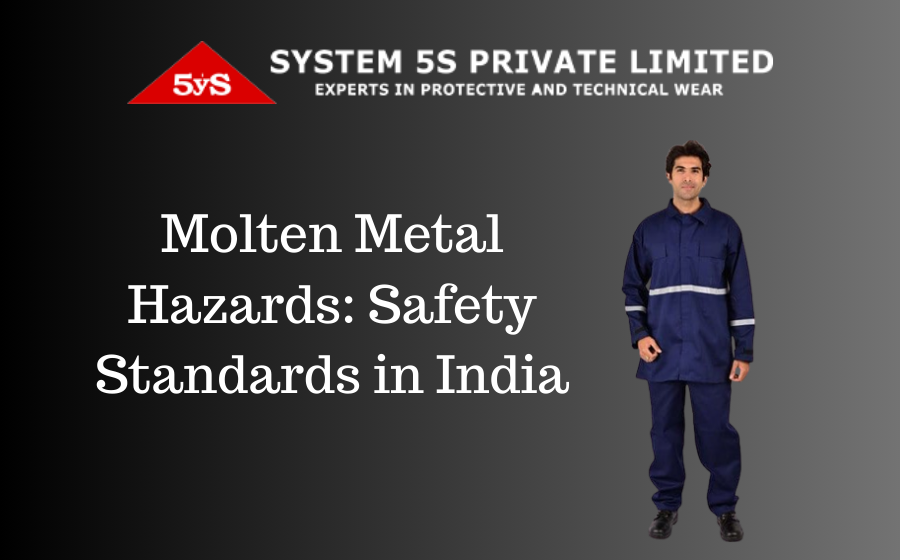
Molten Metal – A Severe Workplace Hazard
In foundries, steel plants, and metal casting facilities, workers routinely handle molten iron, steel, aluminum, and other metals. A splash or spill of this liquid metal can cause instant and severe burns. Unlike ordinary burns, molten metal sticks to surfaces and clothing, transferring intense heat. Victims may suffer deep burns, and nearby materials can ignite. In some cases, explosive eruptions or splashes can even throw workers off balance. These characteristics make molten metal a top safety concern in metalworking industries.
Common injury scenarios include ladles spilling molten iron, furnace eruptions, or splashes during pouring. Such incidents not only burn any exposed skin but can penetrate normal work clothes. That’s why specialized personal protective equipment (PPE) is critical – regular cotton uniforms would catch fire or melt. Molten metal accidents also often involve multiple workers at once, compounding the seriousness of these events.
Indian Safety Guidelines and Standards for Molten Metal Work
Indian law and standards recognize molten metal as a serious workplace hazard and lay down guidelines to protect workers. The Factories Act, 1948 (and State Factory Rules) requires employers to ensure safety in all industrial processes, including foundries. Specific rules mandate protective gear and precautions for molten metal handling. For example, tasks like “work at a furnace where there is risk to the eyes from molten metal” or “pouring or skimming of molten metal” are explicitly listed as operations that require proper eye and face protection. This means workers doing metal casting or furnace work must be provided with safety goggles or face shields to guard against splashes.
Personal Protective Equipment (PPE) Rules: Indian factories must supply appropriate PPE to all workers exposed to hazards. Factory rules state that “all workers should be mandatorily provided with PPEs as required… and such PPEs shall conform to the relevant national standard”. In practice, this means foundry workers handling molten metal should receive flame-resistant jackets or aprons, face shields, gloves, leggings/gaiters, and safety boots that meet Indian Standards. The rules also mention “suitable gloves, leather gauntlets and mittens conforming to relevant National Standard shall be used” to protect workers’ hands. This legal framework (under the Factories Act) makes it clear that ordinary clothing is not enough – certified protective clothing is a must when dealing with molten metal.
Importance of Specialized Protective Gear and Maintenance
Workers’ protective garments should be kept in top condition – clean, intact, and free of damage – to ensure maximum safety. Even the best protective gear can fail if it’s worn-out or improperly maintained. Molten metal PPE often has special coatings (like aluminized surfaces that reflect heat, or leather treated for fire resistance) which can be compromised by soil, oil, or wear and tear. Indian guidelines (and good safety practice) advise regular inspection and maintenance of PPE. Employers should replace any charred, thin, or torn protective clothing immediately, as even a pinhole can let molten metal through.
In India, companies like System 5S emphasize not only providing quality safety gear but also proper upkeep. For example, contaminated workwear can lead to reduced flame resistance or foster bacteria (if soaked in sweat), so industrial laundry and repair services are offered to keep gear clean, durable, and reliable. Regular cleaning removes flammable oil/grease and metal particles, while timely repairs (fixing broken fasteners, patching holes) extend the life of costly protective clothing. This ensures that a jacket or apron will perform as designed when a real incident occurs.
Key Takeaway
Molten metal hazards are a reality in India’s manufacturing sector – but the injuries and tragedies are preventable. Adhering to Indian safety standards like the Factories Act and BIS PPE specifications can dramatically reduce these risks. It is vital for employers to provide specialized protective gear and ensure workers actually wear them. Equally important is fostering a safety culture of maintenance, training, and vigilance. Workers should be trained in safe pouring techniques, emergency responses (e.g. eyewash for splashes), and the importance of keeping their protective gear in good condition.
In summary, molten metal safety isn’t just a regulatory checkbox but a life-or-death matter. With the right gear – meeting IS standards for molten metal protection – and strict compliance with safety guidelines, companies can protect their employees from horrific burn injuries. The investment in proper PPE and training pays off by preventing accidents, saving lives, and avoiding the human and economic costs that come with every molten metal incident. For Indian industry, striving toward zero accidents in foundries and steel plants is an achievable goal – and it starts with recognizing the risks of molten metal and taking all possible precautions to mitigate them.